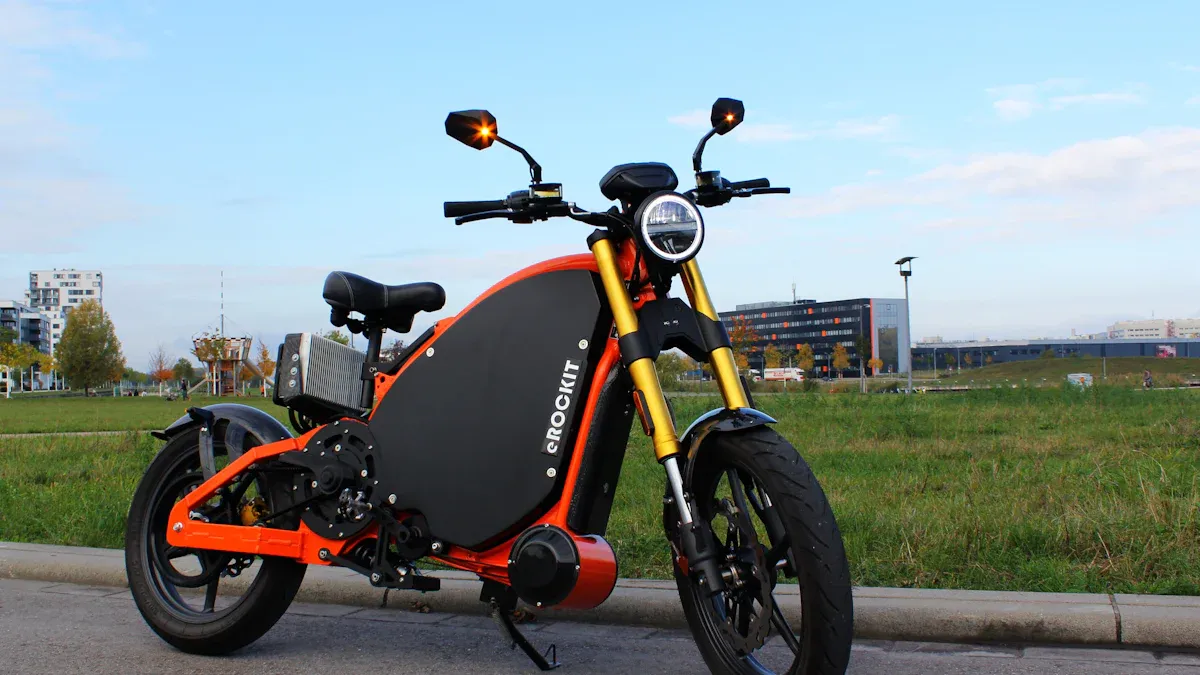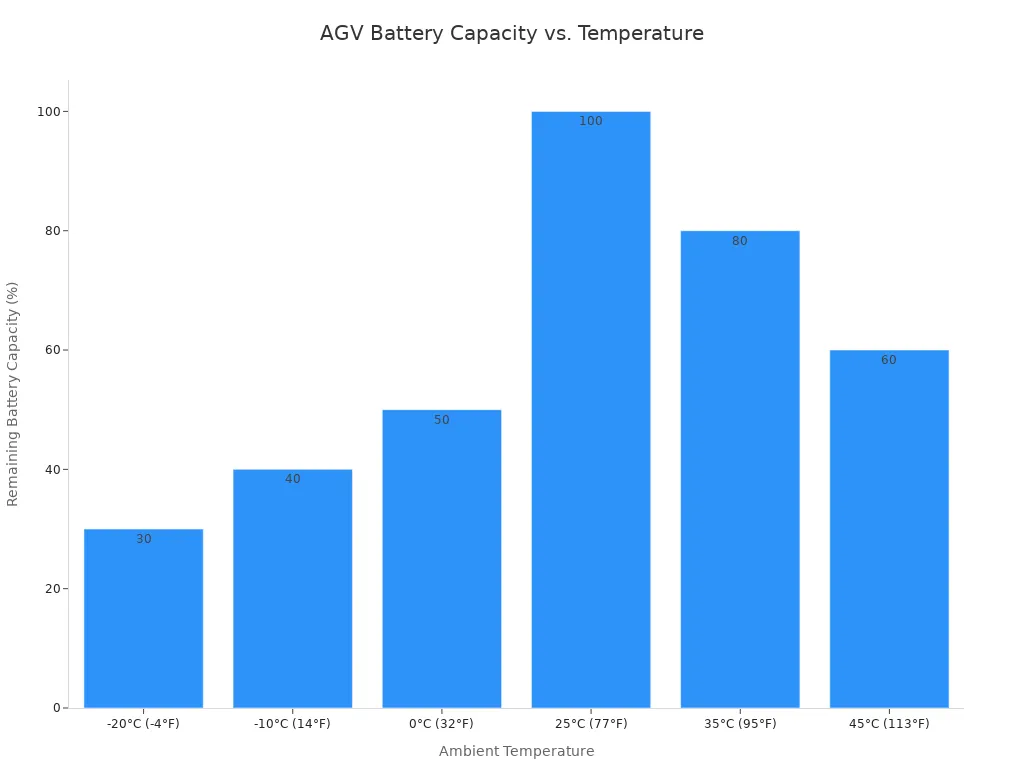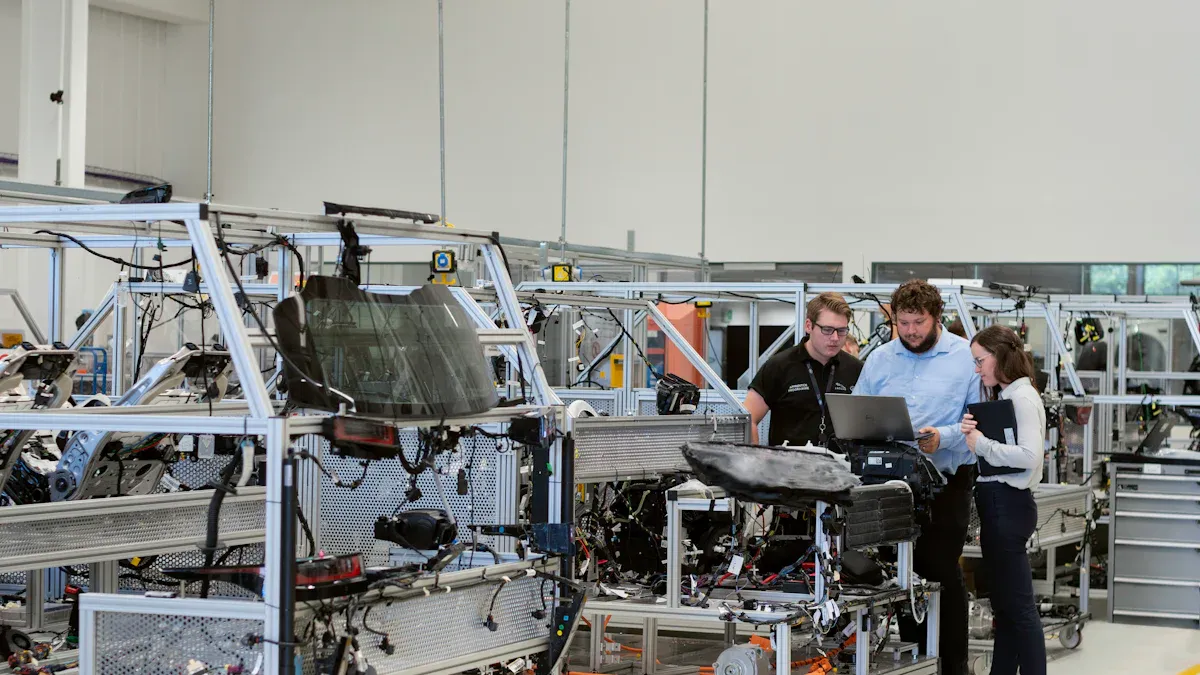
You can significantly boost your AGV’s performance without a complex hardware upgrade. The most effective fix is a simple change to your charging habits. Adopt “opportunity charging” to avoid the deep battery discharges that degrade battery health. This method is a major improvement over the common but harmful “run-to-die” approach.
Inefficient charging is a major source of downtime.
- Charging pit stops can consume 15-20% of productive operational time.
- Charging issues may account for 20-30% of total robot downtime.
This simple fix helps you improve battery life, reduce long-term replacement costs, and increase overall fleet efficiency.
Optimize Charging to Improve Battery Life

Your charging strategy is the simplest and most impactful fix for better AGV battery life. Inefficient charging habits can cause 20-30% of your total robot downtime. You can reclaim this lost time by optimizing how and when your AGVs charge. This single change delivers immediate results for your entire operation.
Implement Opportunity Charging
Opportunity charging is a strategy where AGVs receive short, frequent charges during natural pauses in their workflow. This approach contrasts sharply with the damaging “run-to-die” method. Running a battery until it is nearly empty and then charging it fully causes significant stress and shortens its lifespan.
Opportunity charging keeps your batteries within a healthy state of charge. This method is especially effective for modern lithium-ion batteries. However, you must use it correctly with older lead-acid batteries, as partial charges can cause damage without periodic full “equalization” charges.
Consejo profesional: A modern Battery Management System (BMS) is crucial. It integrates with your AGVs to ensure safe voltage and temperature levels. It also enables smart charging algorithms that prevent overheating and preserve battery health.
Here is a comparison of charging methods for traditional lead-acid batteries:
| Feature/Method | Opportunity Charging (Lead-Acid) | Conventional Charging (Lead-Acid) |
|---|---|---|
| Lifespan Impact | Decreases lifespan by up to 40% without proper management. | Ideal method for maintaining lifespan. |
| Sulfation Risk | High risk if not fully charged periodically. | Prevents sulfation by ensuring full charges. |
| Downtime | Reduces downtime by allowing quick top-ups during idle time. | Increases downtime with long charge and cooldown periods. |
Identify Strategic Charging Points
Effective opportunity charging depends on where you place your charging stations. You should create a decentralized charging infrastructure. This means spreading charging points throughout your facility instead of having one central charging room.
Place charging stations along your AGV’s existing routes. Good locations include:
- Loading and unloading docks
- Staging areas
- Workstations where AGVs pause
- Turnarounds or brief waiting points
This strategic placement allows AGVs to get a quick energy boost without interrupting their tasks. It eliminates the need for long trips to a distant charging station, which maximizes operational uptime and improves your fleet’s energy efficiency.
Set Smart Charging Thresholds
You need to tell your AGVs when to charge. You can do this by setting smart charging thresholds using your fleet management software. This software uses data from the AGV’s Battery Management System (BMS) to make intelligent decisions.
For lithium-ion batteries, the optimal operating range is between a 20% and 80% state of charge (SoC). Your fleet management system can automate this process.
- The system monitors the SoC of every AGV in real-time.
- It identifies an AGV’s scheduled idle time or natural work pauses.
- When an AGV’s charge drops below a set threshold (e.g., 30%), the software directs it to the nearest available charging station.
- The AGV charges for a short period, just enough to get back into a healthy SoC range.
This data-driven approach ensures your AGVs are always ready for work. It also optimizes your overall battery performance and prevents unnecessary charging cycles that wear down batteries.
Avoid the 100% Charge Trap
You might think charging a battery to 100% is best. This belief is a common mistake that actually harms your batteries. Consistently charging to full capacity puts significant stress on the battery’s internal chemistry and accelerates its degradation. This is especially true for lithium-ion batteries.
Here is why you should avoid the 100% charge:
- Chemical Stress: High voltage from a full charge accelerates chemical wear and tear inside the battery.
- Microcracking: Charging above 75% can cause tiny cracks in the battery’s cathode, leading to permanent capacity loss.
- Heat Damage: Pushing a battery to 100% generates more heat. Heat is a major enemy of battery health.
Avoiding full charges is a simple way to improve battery life. By keeping the charge level below 80-90%, you reduce stress and slow down the aging process. This simple habit helps you improve battery life and get more value from your investment.
Boost Efficiency with Simple Fixes
Beyond charging, you can make several simple fixes to your AGVs and their environment. These adjustments reduce the energy your robots need to complete their tasks. Less energy used means longer operational time between charges.
Lighten Your AGV’s Load
A heavier AGV needs more energy to move. Reducing its weight is a direct way to improve battery life. Every pound you remove helps the battery last longer. Modern AGV manufacturers use lightweight materials to boost efficiency.
You can look for these materials in your AGVs:
- Aluminum alloys for the frame and body.
- Composite materials for the robot’s structure.
- Lightweight components in the drive train and control unit.
Quick Tip: Review the payloads your AGVs carry. Ensure you are not consistently overloading them. Sticking to specified load limits prevents the motors from drawing too much power and draining the battery.
Program Smarter, Smoother Routes
The path your AGV takes has a big impact on energy use. Frequent stops, starts, and turns drain the battery quickly. You can use route optimization software to create more efficient paths. These smart routes minimize acceleration and turning. Studies show that energy-efficient path planning can reduce AGV energy consumption by 10.98%.
You can program several smart routing strategies to conserve power:
- Dynamic Tasking: Assign tasks based on an AGV’s battery level. A fully charged robot can handle a long-distance job. A robot with less charge can take a shorter task near a charging station.
- Energy-Aware Routing: Choose paths that use the least energy, not just the shortest distance. This strategy helps AGVs avoid steep ramps or rough floor surfaces.
- Obstacle Avoidance: Plan routes to reduce cross-traffic. Fewer obstacles mean fewer stops and starts, which saves significant energy.
Control Your Operating Environment
Temperature is a critical factor for battery health. Extreme heat or cold can drastically reduce your battery’s capacity and lifespan. You should aim to operate your AGVs in a temperature-controlled environment to get the best battery performance.

The ideal operating temperature for most batteries is between 20°C (68°F) and 25°C (77°F). Deviating from this range has serious consequences.
| Temperature Range | Impact on Battery Performance |
|---|---|
| High Temperatures (>30°C / 86°F) | Capacity drops and battery life is significantly reduced. Life can be cut in half for every 8°C rise above 25°C. |
| Low Temperatures (<0°C / 32°F) | Capacity can drop by 50% or more. Charging becomes very inefficient. |
| Extreme Cold | En electrolyte can freeze in a low-charge battery, causing permanent damage. |
Keeping your facility’s temperature stable protects your battery investment and ensures your AGVs operate reliably.
Maintain AGVs to Extend Robot Battery Life
Regular checks are essential for a healthy fleet. A good battery maintenance program helps you spot problems before they cause major downtime. Proper care ensures your AGVs can always reach their charging stations when needed.
Create a simple checklist for your team. This makes routine battery maintenance easy to follow.
- Listen and Look: Operate the AGV and listen for any unusual noises. Visually inspect the robot for damage.
- Check Voltage: Verify the battery voltage is at the correct level as stated in the product manual.
- Inspect for Leaks: Look for any signs of oil or battery fluid leaks around the AGV.
Always follow the manufacturer’s guidelines for operation and care. Adhering to their recommendations for temperature, charging, and design will help you extend your robot battery life and keep your warranty valid.
Upgrade Your AGV Technology

Simple fixes improve daily operations. However, long-term gains come from upgrading your core technology. Investing in modern batteries and charging systems can transform your fleet’s efficiency and lower your total cost of ownership.
Choose the Right Battery Chemistry
Upgrading from old lead-acid batteries to a modern batería de iones de litio is a game-changer. Lithium-ion technology offers significant advantages for demanding AGV environments.
- Longer Lifespan: A lithium-ion battery provides 3,000 to 5,000 charge cycles, while lead-acid batteries only offer 1,000 to 1,500.
- Faster Charging: You can charge them in just 1-2 hours, compared to 8 hours for lead-acid.
- No Maintenance: They are virtually maintenance-free, saving you labor costs.
Lithium Iron Phosphate (LiFePO₄) is an especially safe and durable type of lithium-ion battery. It handles high-demand, multi-shift operations well. While the initial cost is higher, the long-term savings are substantial. A LiFePO₄ battery eliminates replacement costs and lowers charging expenses, making it a smarter investment over time.

Leverage an Advanced BMS
A modern Battery Management System (BMS) is the brain of your battery. It is essential for the safety and longevity of a lithium-ion battery. The BMS monitors key data in real-time to protect your investment. It prevents common issues like overcharging, over-discharging, and overheating.
An advanced BMS optimizes your battery performance. It uses cell balancing to ensure all cells charge and discharge evenly. This process prevents imbalances that can shorten battery life. The BMS also communicates with the charger to adjust charging rates, which protects the battery from stress and extends its operational life.
Explore Wireless Charging Options
Wireless charging technology removes the need for physical contact points. AGVs can charge by simply parking over a charging pad embedded in the floor. This method is highly efficient, with systems reaching up to 90% power transfer efficiency.
This technology enables “in-process charging.” Your AGVs can get quick power boosts during natural pauses in their workflow without ever leaving their route. Because there are no mechanical parts, you eliminate maintenance issues like broken cables or dirty contacts. This keeps your fleet running 24/7 with less downtime.
You can make a big difference in your AGV’s performance. The best change is moving from a “run-to-die” cycle to an opportunity charging strategy. Simple fixes like optimizing routes and upgrading to lithium-ion batteries also provide major benefits.
Your action plan is simple. Start today by analyzing your AGV’s workflow to find natural pauses. This single step will help you find the perfect spots for charging. You can immediately begin to improve battery life and boost your fleet’s efficiency.
PREGUNTAS FRECUENTES
What is opportunity charging?
Opportunity charging means you give your AGVs short, frequent charges during their natural work pauses. This method avoids draining the battery completely. It keeps your AGVs running longer and protects the battery from stress, unlike the harmful “run-to-die” approach.
How do I start using opportunity charging?
You can start with a simple plan.
- Watch your AGV’s daily route.
- Find a spot where it already stops or waits.
- Place a charging station in that location.
This single change allows your AGV to get quick power boosts without stopping its work.
Is a lithium-ion battery really better? 🔋
Yes, a lithium-ion battery offers major advantages. It charges much faster than older lead-acid types. It also lasts for thousands more charge cycles. This upgrade saves you time and reduces long-term replacement costs, making it a smart investment for your fleet.
Should I always charge my AGV to 100%?
No, you should avoid charging to 100% regularly. This practice puts stress on the battery’s chemistry and can shorten its life.
Quick Tip: Keeping the charge level between 20% and 80% is the ideal range. This simple habit helps you maximize your battery’s lifespan and performance.

